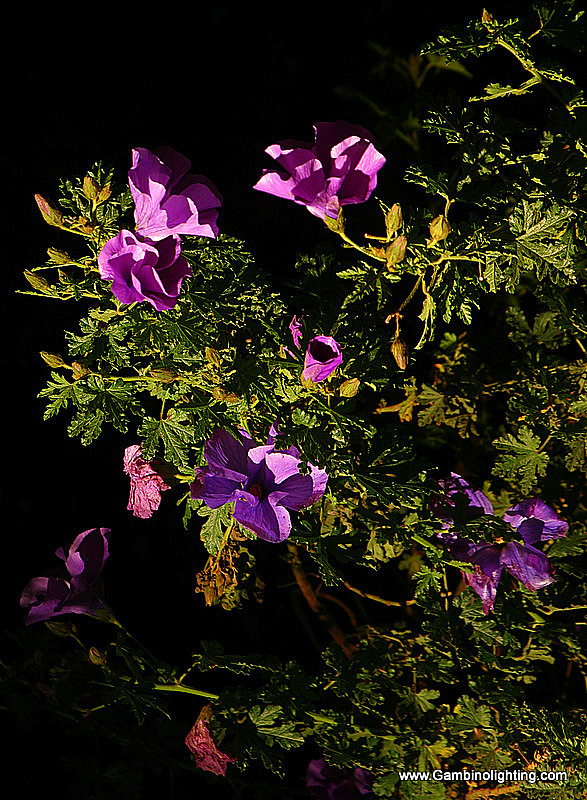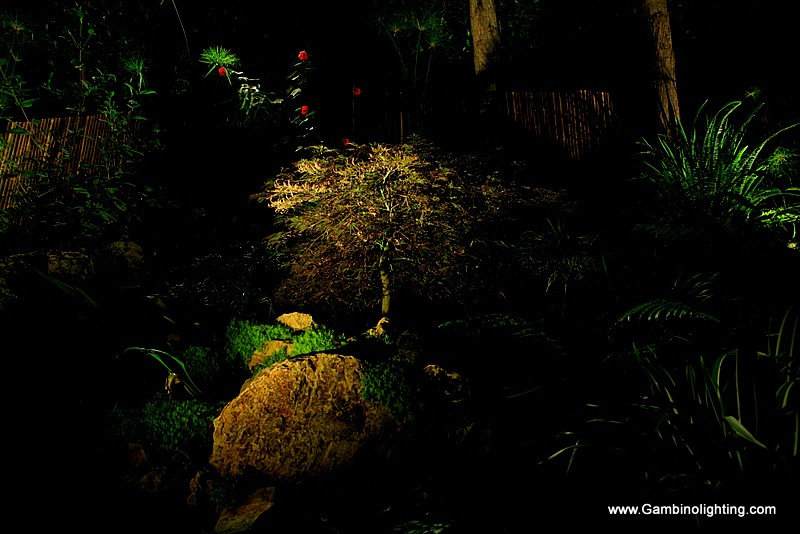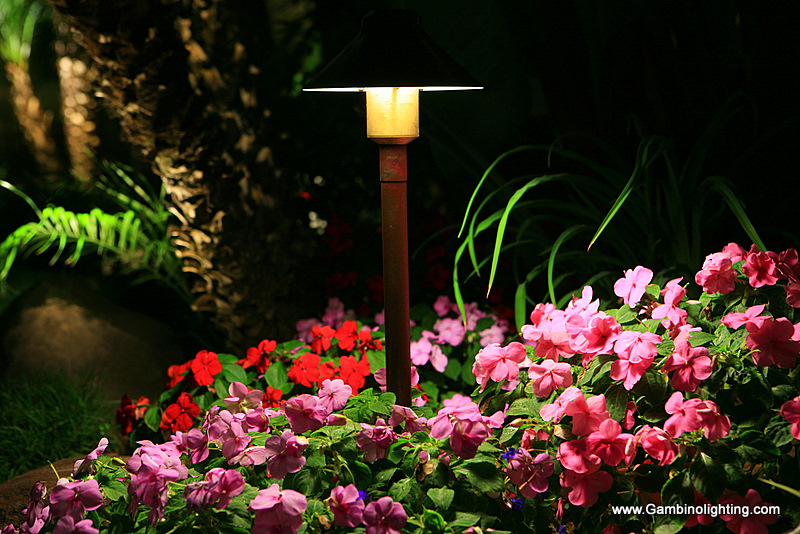04 Nov Knowing Plants is as important as knowing landscape light and fixtures
By Mike Gambino
In garden lighting, knowledge of plant materials is just as important as the knowledge of the fixtures. The growing habits of the various plants, the type of foliage the plant is to have, its ultimate size, whether it will spread out or grow straight up – all these are important. There should be knowledge of all types of plants, leaves, trees, and foliage as to their acceptance or absorptions of light. Some reflect light, some absorb light.
 Plant material with dark, thick leaves tend to absorb more light than plant material with light, thin leaves which are more transparent. For example, uplighting a Ficus tree will require a different application than when uplighting a Jacaranda. When considering a project with a mix of evergreen and deciduous trees on a limited budget, you will find that choosing the deciduous trees will give you a stronger impact for your dollar as they tend to reflect more light than they absorb.
Plant material with dark, thick leaves tend to absorb more light than plant material with light, thin leaves which are more transparent. For example, uplighting a Ficus tree will require a different application than when uplighting a Jacaranda. When considering a project with a mix of evergreen and deciduous trees on a limited budget, you will find that choosing the deciduous trees will give you a stronger impact for your dollar as they tend to reflect more light than they absorb.
 Light follows the same principals with hardscape as well. Dark paving materials such as asphalt absorbs more light than light colored or black paving materials such as asphalt can be extremely difficult to light. When moonlighting, the color of the surface of the ground is an important element when choosing lamp wattage.
Light follows the same principals with hardscape as well. Dark paving materials such as asphalt absorbs more light than light colored or black paving materials such as asphalt can be extremely difficult to light. When moonlighting, the color of the surface of the ground is an important element when choosing lamp wattage.
It is also important to know which lamps put out warm light versus bright light. Warm colors include red, orange, and yellow, while cool colors include blue, green, and magenta. The following are descriptions of light output with the type of lamp chosen:
- Incandescent – warm yellow
- LED – warm and cool white
- Xenon – warm yellow, less so than incandescent
- Candle – very warm yellow
- Halogen – crisp white light
Imagine sitting on a patio in the early evening socializing with friends. If you have a lamp above you emitting blue and green wavelengths, everyone’s skin tone would look ghoulish and ghostly. If you instead used a lamp with yellow-orange wavelengths, everyone’s faces would look warm and full of life.
A common practice when deciding how to design a landscape with warm and cool colors is to keep warm yellow colors around the home and in intimate sitting areas, and to use crisp white light in the surrounding landscape. Warm colors tend to make us feel comforted and warm, reminding us of candles and fireplaces. Cool colors tend to feel more bright and harsh.
Since flower beds and shrubs will generally have a range of colors, it is best to use a crisp white light (which most closely resembles sunlight) so that all colors can be fully enhanced.
 We often advise clients to be cautious when using colored lenses. The reason being is that if you mix the wrong colored lens and color surface, your result can be a sick or dead looking object. For example, if you use a red lens on a green plant, red and green mixed together make brown, then the result will be unsightly. The color-wheel can tell you which colors don’t mix well together. Any colors opposite each other on the color-wheel will mute each other into a dark brown and eventually turn black. We know that a yellow lens on a purple surface will also create a dull effect because they are on opposite sides of the color-wheel.
We often advise clients to be cautious when using colored lenses. The reason being is that if you mix the wrong colored lens and color surface, your result can be a sick or dead looking object. For example, if you use a red lens on a green plant, red and green mixed together make brown, then the result will be unsightly. The color-wheel can tell you which colors don’t mix well together. Any colors opposite each other on the color-wheel will mute each other into a dark brown and eventually turn black. We know that a yellow lens on a purple surface will also create a dull effect because they are on opposite sides of the color-wheel.
Colors are best enhanced when combined with those on either sides of them on the color-wheel. For example, mixing blue and green gives you teal. Mixing blue and purple gives you violet. But it is not that simple. You still need to be cautious because there are millions of different shades of every color, and each shade will react differently.
In all cases when using a colored lens, make sure that you are lighting a specific target and avoid light spillage onto adjacent surfaces. Most likely the colored lens will not positively enhance surrounding objects. This is easier to do with the control that low-voltage landscape lighting offers, but still a challenge in the outdoors where most of your pallet is growing and changing.
This landscape lighting blog is published by Mike Gambino of Gambino landscape lighting inc. all rights reserved. Mike is a professional landscape lighting system designer/ builder and has been designing, installing and maintaining landscape lighting systems for more than 20 years. Mike resides in the Los Angeles area with his wife and 2 sons. To visit his website go to www.gambinolighting.com . To inquire about hiring Mike please click here .
Blog articles may be published with permission on other websites without editing or removing links.



No Comments